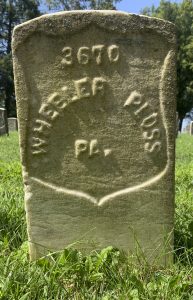‘Not For Themselves’
At least four county natives among those buried at Antietam National Cemetery

Times Observer photo by Josh Cotton This statue sits in the center of the Antietam National Cemetery. It’s called “Private Soldier” and carries a very simple inscription - “Not for themselves, but for their country.”
- Times Observer photo by Josh Cotton This statue sits in the center of the Antietam National Cemetery. It’s called “Private Soldier” and carries a very simple inscription – “Not for themselves, but for their country.”
- The grave of Wheeler Ploss in the Antietam National Cemetery.
- The grave of William Fredenburgh in the Antietam National Cemetery.åç
- John Anderson is one of at least four Warren County natives buried at the Antietam National Cemetery outside of Sharpsburg, Md.
This is one of those.
A few weeks ago we were vacationing with family in Gettysburg when we took the drive down to Antietam, the site of the Sept. 17, 1862 battle that has been called the bloodiest day in American history. Approximately 23,000 men became casualties meaning they were killed, wounded or missing in action.
Both the Union and Confederate armies held roughly the same line at the end of the day that they did at the beginning. For that reason, the battle is often considered a draw. It’s most significant and lasting contribution, though, was that it was enough of a victory for Abraham Lincoln to issue the Emancipation Proclamation in its wake, shifting the war from one of preserving the union to abolishing the institution of slavery.
With over 2,200 men in the service, it’s no surprise that Warren County was well represented on that bloody field that September day. Co. D of the 111th – most notable for being raised by one George Cobham had a company commander I’ve written quite a bit about – Capt. William Alexander.

The grave of Wheeler Ploss in the Antietam National Cemetery.
The 111th went into Antietam with a total of 243 men. By the end of that day, the number would nearly be cut in half – 33 were killed or mortally wounded (meaning that the wound was fatal) while another 71 were wounded and eight were missing.
In the wake of the battle, those killed in action would be buried approximately where they fell on the field. Those graves were notoriously shallow. According to the National Park service, many had become exposed less than two years later.
That effort spurred the birth of the Antietam National Cemetery Board. Per the NPS, 4,776 Union Soldiers – 38 percent are unidentified and unknown – were reinterred there in an effort that was completed in September 1867.
Four of the men killed in Co. D from Warren County rest there.
WHEELER PLOSS

The grave of William Fredenburgh in the Antietam National Cemetery.åç
Wheeler Ploss was one of four brothers that enlisted in Co. D of the 111th. He and his brother Timothy were mustered into service Nov. 2, 1861 in Erie and Abner and Jacob followed on Nov. 29, 1861.
Wheeler was 17 or 18 when he enlisted as a private in Warren County on Oct. 3, 1861, according to Antietam on the Web. The muster rolls for the regiment list him “killed at Antietam” on Sept. 17, 1862. His page on Antietam on the Web said he was buried on the field and reinterred into the national cemetery in 1867.
The same Warren Mail article that reported Wheeler’s death that Timothy had been wounded in the knee. He was discharged for medical reasons the following April. He committed suicide by hanging himself in his barn in 1874. It’s difficult to not wonder how the effects of his service – including the possibility he watched his brother die – played into that decision.
Wheeler’s two other brothers in Co. D – Abner (in Sept. 1862 before Antietam) and Jacob (Feb. 1863) were also both discharged for medical reasons.
WILLIAM

John Anderson is one of at least four Warren County natives buried at the Antietam National Cemetery outside of Sharpsburg, Md.
FREDENBURGH
William Fredenburg, or Freadenburg, or Fredinburgh (your choice!) also enlisted in November 1861 as a private.
The Warren Mail reported that his leg had been broken in the fighting. But, according to Antietam on the Web, the wound was mortal. He was taken to the Smoketown field hospital where his leg was amputated. That operation was unsuccessful and he died in early November.
JOHN ANDERSON
Like the two men before him, he also enlisted in Nov. 1861. Per Antietam on the Web, Anderson, born in 1838 in Sweden – was shot in the right hip in a word that turned out to be mortal.
He was reported wounded in the “thigh” by the Warren Mail and service records indicate he died of that wound on Oct. 14.
DAVID L. BROWN
Brown was mustered in on the same day as Ploss. Here, there’s a discrepancy between sources.
Service records indicate that he was killed on Sept. 17 but Antietam on the Web suggests he was mortally wounded and transferred to the Franklin Hall Hospital in Chambersburg where he died. It’s believed he was buried there before being re-interred in the cemetery in 1867.
The Mail also reported him “killed.” It’s possible, given the confusion of the scene, that either possibility is accurate. It’s also not inconceivable that he was believed dead – and a comrade reported as much – but wasn’t.




